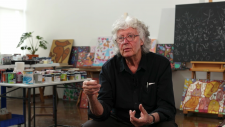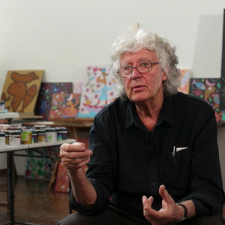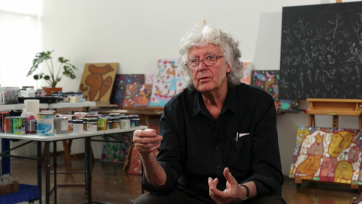- All children, I find, love to draw, and it gets to a point where they stop drawing. But I like the humorous drawing and the naughty drawing, that little cheeky drawing that most children do like this. Drawing is a primal kind of thing, it doesn't speak to the mind, it speaks to the heart a bit more and to the emotions and to the subconscious. I had, somehow, a bit of courage to just say what I thought, but try and make it into a form, like a poetic form, something that wasn't bland me blabbing on about what I thought, it was trying to lyrical and evoke something, and the mystery of life. These were just a natural philosopher in a young kid. Most kids are like this, they say to you, "What happens when you die?" You know this is the same thing that kept going in me, "What is going on here, "is this political system as serious as it looks? "Are these people genuine?" You ask rude questions within yourself. So that's what a cartoonist is, a political cartoonist in the tradition, you ask improper questions, but you do it in a sort of charming, accessible way, and you express what is repressed. That's what I was doing, I was expressing the questions that I repressed, that you don't dare ask 'cause they're not proper, but a cartoonist is given a licence, in a good newspaper, to be a little improper. There's a very strict tradition in cartooning, you gotta do a punchline that everyone gets and appeals to everyone, but I say, "Yeah but people have a little poetic dimension in them, they have a mystery. That's why they hear music, they don't have to get music, just kind of goes into them and they say, "Yes I like that." And I thought, why can't a cartoon be like that, it's a picture, that's all it is to me, it's gotta be lyrical or mysterious or funny or touching, it's like a little song except it's just with a line. And I stepped away from the normal conventions of cartooning, of the punchline, or just picking on political mistakes. My natural interest was, what is my part in this? What is our part in the mess we're in? And be touching, open it up, don't nail it, have more interest in pulling the nails out than opening it. If you open with your heart, you'll open with each other, you'll open with yourself. I think flow and I think tight and constricted. So part of a cartoonist, this cartoonist's work, is to be maybe a liberating influence to the extent I can. These are not the normal subjects of cartoons in newspapers! I start by being conscious of what seems to be in the air, what's in the zeitgeist? I start from that point saying, what can I offer here? What can I say about this that makes sense of it, That makes a little bit of meaning or gives perspective to it, humanises a very dehumanising world? Or something. And I start playing with that, and it's a playful experimental mess I make on the paper, drawing and destroying the drawing, and it gets worse and it gets worse, and I go, "Oh God I can't do this, these are terrible." And so I become a little primal in my process, I'm not in control of drawing like a great craftsperson or something, I'm just a bit lost. And I think I need to lost a lot. Some of my best work comes if I do lose my way and then have to find something in the mess or in the lostness. All you've got to offer is yourself, your own experience, your own kind of philosophy. That's all you've got. You've gotta be able to make your mistakes and be forgiven because you need a mistake to find your new pathway I think. It's not just about being a clever commentator it's about enlightening and humanising, it's just bringing our souls to life, and that's part of the process. It's not just political consciousness raising, it's just consciousness raising, and making feelings seem worthwhile and fertile and productive and useful to a saner world. I think it's about sanity, basically. Somewhere the work is about every improbably depiction of this healthier, kinder, saner world. And a funnier world, and a more poetic world. And I know it's working when I'm laughing at it as I'm drawing it, and enjoying it and lost in it. Because if you don't enjoy making a piece of work, well no one's gonna enjoy looking at it. That's a basic principle. And if you can't open yourself up, you can't open other people up, other people won't open up. People are open to your work to the extent you've opened in the making of that work, and made yourself vulnerable and offered something for better or for worse. And things work in mysterious ways. I guess the characters I've drawn were not designed so much, they just came off the end of the pen a little bit. They're incredibly ridiculous-looking, because they have noses that are far too big and eyes that are too big, and their always in profile, so they're very simplistic, they're more like hieroglyphs. They are just more symbols in this fairly simple, this profile of galoot, this strange fore of a person. I think I'm drawing the human spirit, or aspects of the human spirit, and everyone can look at this dopey character I draw and say "Ha, this is not a handsome person, look and their nose, "look at their bad posture, look at them stumbling along!" And suddenly one can feel a bit in control. You know in the square on the page where the cartoon is contained, that's like a stage, it's a little stage, and then I put these characters in and they interact and they say words or a duck walks on. The first duck came into my cartooning work simply because I just felt the duck should be in the drawing, as simple as that. It's like you put a bit of herb in a cooking, and it adds a touch. I got sick of the fact that political commentary is always about us humans, and maybe subconscious would say, "Come on, turn to the little primal thing, "the little innocent thing, "The intuitive thing that just waddles on regardless," and I think well, we've all got an inner duck and it's as if I'm referring to an aspect of our human character which we might neglect too much, and which we might turn to sometimes when we get a bit sad or lost. Maybe you have a little intuition in there, a playfulness, a good nature, an innocence. Remember it, and feed it.
- About us
- Support the Gallery
- Venue hire
- Publications
- Research library
- Organisation chart
- Employment
- Contact us
- Make a booking
- Onsite programs
- Online programs
- School visit information
- Learning resources
- Little Darlings
- Professional learning







